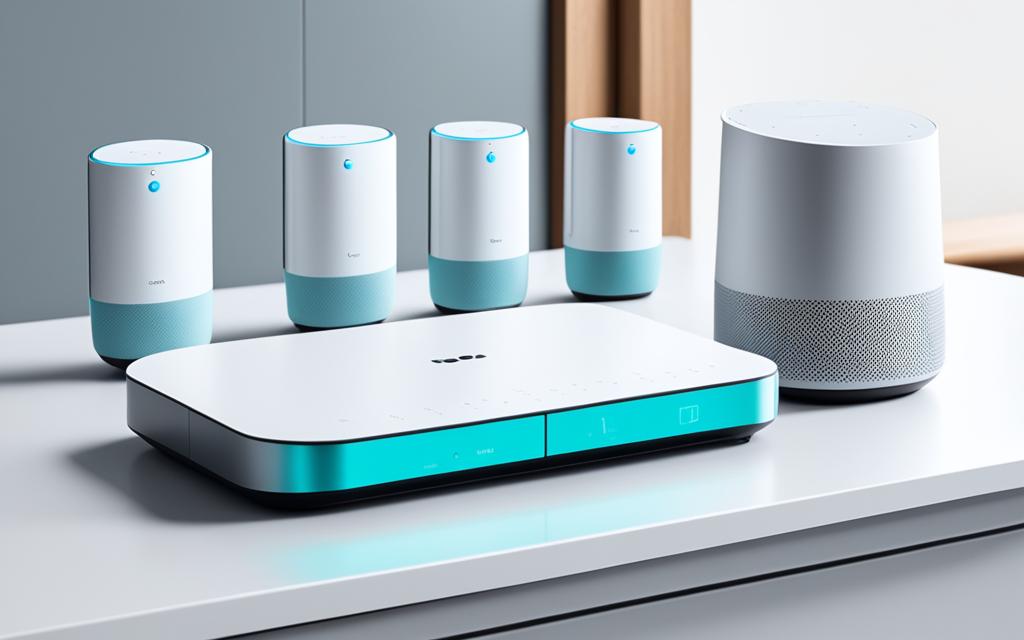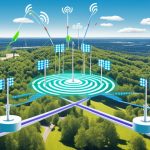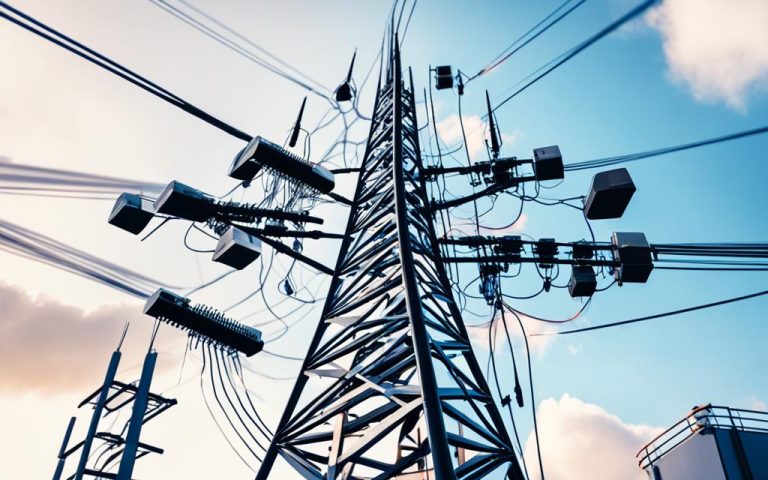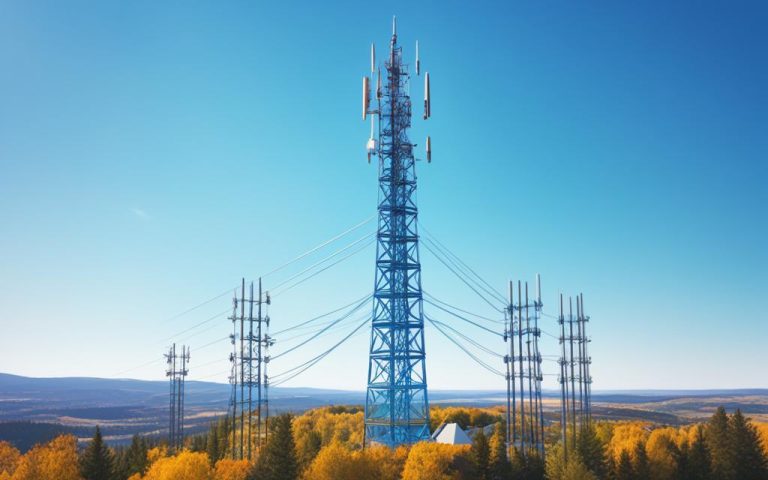The Internet of Things (IoT) has emerged as a transformative technology that is revolutionizing how businesses operate and make decisions. Combining IoT with Fixed Wireless Networks creates unprecedented opportunities for connectivity, driving technological advancements in industries across the board. With the increasing need for seamless connectivity and the demand for reliable and efficient data transfer, the integration of IoT and fixed wireless networks has become crucial.
Fixed Wireless Networks provide stable and reliable broadband internet access without the need for traditional cabled infrastructure. By leveraging Fixed Wireless, organizations can overcome the limitations of physical infrastructure and extend connectivity to otherwise challenging areas. The integration of IoT with Fixed Wireless Networks enables businesses to harness the power of data, automation, and real-time insights, resulting in enhanced operational efficiency, improved customer experiences, and better decision-making.
This article will delve into the intricacies of IoT integration with Fixed Wireless Networks, exploring the benefits, technical details, and future prospects of this powerful combination. We will also examine the potential challenges and limitations that organizations should be aware of as they embark on their IoT and Fixed Wireless integration journey. Stay tuned to discover how this integration can propel your business forward in the era of technological advancements and connectivity solutions.
What is the Internet of Things (IoT)?
The Internet of Things (IoT) is a network of devices that are interconnected and can exchange data with each other and the cloud. These devices, which can be anything from consumer objects to industrial machines, are equipped with sensors and software that enable them to collect and transmit data without the need for human intervention. This technology has revolutionized various industries by enhancing operational efficiency, improving customer service, and providing valuable insights.
IoT devices are embedded with sensors and software that enable them to collect and transmit data. These interconnected devices facilitate seamless data transfer and communication, allowing organizations to make data-driven decisions and automate processes. The data collected by IoT devices can provide valuable insights into operations, customer behavior, and overall system efficiency.
IoT technology has wide-ranging applications across industries. In the healthcare sector, IoT devices can monitor patients’ vital signs and provide real-time updates to healthcare professionals. In manufacturing, IoT devices can optimize production processes and enable predictive maintenance. In transportation, IoT devices can track inventory and monitor vehicle performance. The possibilities are endless.
“The Internet of Things (IoT) is the network of physical devices, vehicles, appliances, and other objects embedded with sensors, software, actuators, and connectivity which enable these things to connect and exchange data.” – Gartner
One of the key advantages of IoT is the ability to gather and analyze vast amounts of data. This data can be used to gain valuable insights, optimize processes, and improve decision-making. By leveraging IoT technology, organizations can enhance operational efficiency, reduce costs, and deliver better products and services to customers.
With IoT devices becoming increasingly prevalent in our daily lives, industries are embracing this technology to gain a competitive edge. From smart homes to connected cars, IoT is transforming the way we live and work. As the number of IoT devices continues to grow, so does the immense potential for innovation and technological advancements.
IoT Devices and Data Transfer
IoT devices rely on various technologies to enable data transfer and communication. These technologies include Wi-Fi, Bluetooth, RFID, and cellular networks. Each technology has its own strengths and weaknesses and is used based on specific requirements and use cases. For example, Wi-Fi is commonly used for indoor applications, while cellular networks provide wider coverage and mobility.
Regardless of the technology used, the seamless exchange of data between interconnected IoT devices and the cloud is essential for the success of IoT implementations. This data transfer enables real-time monitoring, analysis, and control, leading to improved efficiency, automation, and decision-making.
As IoT technology continues to evolve, advancements in data transfer and connectivity are expected. The integration of 5G networks will enable faster and more reliable communication, unlocking new opportunities for IoT devices and applications.
To visualize the interconnectedness and data transfer in IoT, the following table illustrates the key components involved:
| Component | Description |
|---|---|
| IoT Device | A physical device equipped with sensors and software that can connect to the internet and exchange data. |
| IoT Gateway | A central hub that connects IoT devices to the cloud and facilitates data transfer. |
| Cloud Platform | A remote server or platform that receives, analyzes, and stores IoT device data. |
| Data Analytics | The process of extracting valuable insights from the collected IoT data using various analytical techniques. |
As the table and image demonstrate, IoT is a complex ecosystem where data flows between interconnected devices, gateways, the cloud, and analytics platforms. This interconnectedness allows organizations to make informed decisions, optimize operations, and unlock new possibilities for innovation.
How does IoT work?
An IoT ecosystem comprises web-enabled smart devices equipped with embedded systems like sensors and communication hardware. These smart devices play a crucial role in collecting data from their surroundings, creating a network of interconnected devices. The collected data is then transmitted to an IoT gateway, which acts as a central hub for data management and analysis.
Data collected by smart devices can be analyzed locally on edge devices before being sent to the cloud. This approach, known as edge computing, helps reduce latency and bandwidth requirements, enabling faster and more efficient data processing.
The communication and connectivity protocols used in IoT vary depending on the specific application and devices involved. Some commonly used protocols include MQTT (Message Queuing Telemetry Transport), CoAP (Constrained Application Protocol), and HTTP (Hypertext Transfer Protocol).
In addition, IoT systems have the ability to leverage artificial intelligence (AI) and machine learning (ML) algorithms to streamline data collection processes. These technologies enable advanced analytics, predictive modeling, and automation, allowing organizations to extract meaningful insights and make data-driven decisions.
Key components of an IoT ecosystem:
- Smart devices
- Sensors
- Communication hardware
- IoT gateway
- Edge devices
- Communication and connectivity protocols
- Artificial intelligence and machine learning algorithms
To illustrate the IoT architecture, the following table provides a comparison of different communication protocols used in IoT:
| Communication Protocol | Description | Advantages | Disadvantages |
|---|---|---|---|
| MQTT | A lightweight publish-subscribe messaging protocol. |
|
|
| CoAP | A simple protocol for resource-constrained devices. |
|
|
| HTTP | A standard protocol for web communication. |
|
|
Why is IoT important?
The integration of Internet of Things (IoT) technology offers numerous benefits to organizations, revolutionizing business processes and enhancing the customer experience. By leveraging IoT, organizations can achieve efficiency, cost reduction, and better decision-making, resulting in improved service delivery and additional revenue generation.
Efficiency: IoT automation reduces the need for human intervention in various operational tasks, leading to streamlined processes and increased productivity. Through the use of interconnected devices and advanced data analytics, organizations can optimize resource allocation, minimize downtime, and improve overall efficiency.
Enhanced Customer Experience: IoT enables organizations to provide personalized and seamless experiences to their customers. By leveraging data collected from IoT devices, organizations can gain actionable insights into customer behavior, preferences, and needs. This data-driven approach allows for tailored products and services, proactive support, and enhanced customer satisfaction.
Cost Reduction: IoT technology helps organizations achieve significant cost savings. By automating processes and reducing manual labor, organizations can minimize operational expenses. Additionally, IoT enables predictive maintenance, allowing organizations to identify and address equipment issues before they result in costly breakdowns or disruptions.
Better Decision-Making: IoT provides real-time insights into systems and operations, empowering organizations to make data-driven decisions. Through the collection and analysis of vast amounts of data, organizations can gain a deeper understanding of their operations, identify trends, and predict future outcomes. This informed decision-making process allows organizations to stay ahead of the competition and seize new opportunities.
Overall, IoT offers a wide range of benefits, including improved efficiency, enhanced customer experience, cost reduction, and better decision-making. By harnessing the power of IoT technology, organizations can unlock new opportunities and drive innovation in various industries.
“The Internet of Things will be the world’s biggest device market and save companies billions of dollars annually.”
– Eric Schmidt, Former Executive Chairman of Google
Benefits of IoT:
- Improved operational efficiency
- Enhanced customer experience
- Cost reduction through automation
- Better decision-making through real-time insights
- Increased productivity and resource optimization
- Additional revenue generation through personalized offerings
Despite its numerous benefits, IoT implementation also comes with challenges and limitations that organizations need to consider. These will be explored in the following section.

What are the pros and cons of IoT?
The Internet of Things (IoT) has ushered in a new era of connectivity and innovation. With its ability to connect and share data seamlessly, IoT offers a range of advantages, as well as some challenges that organizations must navigate. Let’s delve into the pros and cons of IoT to better understand its impact.
Advantages of IoT
IoT brings several benefits that drive efficiency and improve decision-making:
- Access to information anytime, anywhere: IoT enables real-time monitoring and data collection, providing businesses with instant access to valuable insights. This empowers organizations to make informed decisions and take timely action.
- Improved communication: IoT devices promote seamless communication between machines, devices, and users. This enhances collaboration, streamlines processes, and improves overall productivity.
- Data analysis: The vast amount of data generated by IoT devices can be leveraged for advanced analytics. This allows organizations to identify patterns, trends, and customer behaviors, enabling data-driven strategies and personalized experiences.
- Automation of tasks: IoT automates routine tasks, freeing up human resources for more strategic and value-added activities. This increases operational efficiency and reduces manual errors.
Disadvantages of IoT
While IoT offers numerous advantages, it is essential to be aware of the potential challenges and risks:
- Increased potential for cyber attacks: With the proliferation of interconnected devices, the security risks have also escalated. IoT networks are susceptible to cyber attacks, potentially compromising sensitive data and privacy.
- Device management challenges: Managing numerous IoT devices distributed across different locations poses logistical and operational challenges. Ensuring device connectivity, updates, and maintenance require diligent management systems.
- Compatibility issues: Integration and compatibility among various IoT devices and systems can be complex. Interoperability challenges arise when different devices use distinct communication protocols, hindering seamless connectivity.
- Susceptibility to system bugs: With the complexity of IoT systems, bugs and software glitches can arise. These issues can disrupt functionality, leading to downtime and potential financial losses.
Organizations considering IoT implementation should weigh these pros and cons to develop robust strategies that address security concerns, device management, compatibility, and software vulnerabilities.
IoT offers unparalleled access to information, improved communication, data analysis capabilities, and task automation. However, organizations must also navigate potential cyber risks, device management challenges, compatibility issues, and system bugs.
| Advantages of IoT | Disadvantages of IoT |
|---|---|
| Access to information anytime, anywhere | Increased potential for cyber attacks |
| Improved communication | Device management challenges |
| Data analysis | Compatibility issues |
| Automation of tasks | Susceptibility to system bugs |
The Technical Details of Fixed Wireless Access (FWA)
Fixed Wireless Access (FWA) is a connectivity solution that brings broadband internet access using radio frequencies, eliminating the need for traditional cables. This innovative technology consists of a base station, such as a cell tower, and subscriber units acting as modems, enabling users to connect their devices and access the internet.
FWA can be implemented using either 5G or 4G LTE technology, offering different bandwidth and coverage options to cater to various user requirements. This versatility makes FWA a suitable choice for both urban and rural areas.
One of the key advantages of FWA is its cost-effectiveness and ease of installation. Unlike traditional wired connections, there is no need for extensive infrastructure development or physical cabling, resulting in reduced deployment costs and faster implementation.
The diagram below illustrates the technical components and flow of data in a typical Fixed Wireless Access network:
“Fixed Wireless Access (FWA) offers a reliable solution for broadband internet access without the need for cables. By leveraging radio frequencies and subscriber units, users can connect their devices and enjoy high-speed connectivity.”
The Benefits and Limitations of Fixed Wireless Access (FWA)
Fixed Wireless Access (FWA) offers numerous benefits as a connectivity solution, including extending internet access to rural areas, cost-effective deployment, and high-quality connectivity. With FWA, people living in remote locations can now enjoy reliable internet access, bridging the digital divide and empowering communities.
One of the major advantages of FWA is its ability to provide high-speed internet in areas where traditional wired connections are not feasible or cost-prohibitive. By utilizing wireless technology, FWA eliminates the need for extensive cable infrastructure, making it a more cost-effective option for connecting rural communities.
Furthermore, FWA installations are relatively easy and quick to set up, allowing for faster deployment compared to wired connections. This makes FWA an ideal solution for temporary operations or areas that require immediate connectivity, such as disaster-stricken regions or construction sites.
FWA also offers high-quality internet connectivity, delivering speeds comparable to traditional wired broadband connections. Users can enjoy seamless online experiences, whether it’s streaming HD videos, video conferencing, or accessing cloud applications.
However, it is important to recognize that FWA has its limitations. One such limitation is its limited range. Due to the nature of wireless transmission, FWA signals can only reach a certain distance from the base station. This means that users located too far from the base station may experience slower speeds or weaker signals.
Another factor that can affect FWA performance is weather interference. Adverse weather conditions such as heavy rain, strong winds, or severe storms can potentially disrupt wireless signals, leading to temporary service outages or degraded performance.
Additionally, the cost of FWA may be higher compared to other broadband options. While FWA offers cost-effective deployment in terms of infrastructure, the pricing of FWA service plans can vary depending on the provider and location. However, with the ongoing transformation of 5G technology, FWA is becoming more competitive in terms of pricing and performance.
| Benefits of FWA | Limitations of FWA |
|---|---|
| Extends internet access to rural areas | Limited range |
| Cost-effective deployment | Weather interference |
| High-quality internet connectivity | Higher cost compared to other options |
In summary, Fixed Wireless Access offers significant benefits in terms of rural connectivity, cost-effectiveness, and high-quality internet. Despite its limitations such as limited range, weather interference, and potentially higher pricing, the advantages of FWA outweigh the drawbacks for many communities and businesses. With ongoing advancements in technology and the increasing adoption of 5G, FWA is expected to continue playing a crucial role in bridging the digital divide and providing reliable internet connectivity to previously underserved areas.
Conclusion
Integrating the Internet of Things (IoT) with fixed wireless networks opens up a world of possibilities for enhancing connectivity and driving technological advancements across industries. The combination of IoT technology and fixed wireless access empowers organizations to harness the power of data, automation, and real-time insights to improve operational efficiency and make informed decisions.
While there may be challenges to overcome, such as ensuring security and compatibility, the benefits of integrating IoT with fixed wireless networks far outweigh the limitations. By leveraging the scalability and flexibility of IoT devices and the stability and reliability of fixed wireless networks, businesses can unlock new levels of connectivity and innovation.
Looking ahead, the future prospects of integrating IoT with fixed wireless access are bright. As technology continues to advance, we can expect to see even more seamless and efficient connectivity solutions. The integration of IoT and fixed wireless networks will play a crucial role in shaping the future of connectivity, enabling organizations to stay at the forefront of technological advancements and drive growth.
FAQ
What is the Internet of Things (IoT)?
The Internet of Things (IoT) refers to a network of devices that connect and exchange data with each other and the cloud. These devices, embedded with sensors and software, can range from consumer objects to industrial machines. IoT enables data transfer without relying on human-to-human or human-to-computer interactions. This technology has wide-ranging applications and is being used by organizations across industries to enhance operational efficiency, improve customer service, and gain valuable insights.
How does IoT work?
An IoT ecosystem consists of web-enabled smart devices equipped with embedded systems like sensors and communication hardware. These devices collect data from their surroundings and send it to an IoT gateway, which serves as a central hub. Data can also be analyzed locally on edge devices before being sent to the cloud. The communication and connectivity protocols used in IoT depend on the specific application. IoT systems can leverage artificial intelligence and machine learning to streamline data collection processes.
Why is IoT important?
IoT offers numerous benefits to organizations. It helps improve overall business processes, enhances the customer experience, saves time and money, boosts employee productivity, enables better decision-making, and generates additional revenue. IoT automation reduces the need for human intervention, leading to cost savings and improved service delivery. It also provides real-time insights into systems and operations, facilitating informed decision-making and competitive advantage.
What are the pros and cons of IoT?
IoT offers advantages such as access to information anytime, anywhere, improved communication, data analysis, and automation of tasks. However, it also has disadvantages, including increased potential for cyber attacks, device management challenges, compatibility issues, and susceptibility to system bugs. Organizations must consider these pros and cons when implementing IoT solutions to mitigate risks and maximize the benefits.
What is Fixed Wireless Access (FWA)?
Fixed Wireless Access (FWA) is a connectivity solution that uses radio frequencies instead of cables to provide broadband internet access. It consists of a base station (such as a cell tower) and subscriber units that act as modems. Users connect their devices to these subscriber units to access the internet. FWA can be implemented using 5G or 4G LTE technology, offering different bandwidth and coverage options. FWA is particularly well-suited for rural areas and temporary deployments due to its cost-effectiveness and ease of installation.
What are the benefits and limitations of Fixed Wireless Access (FWA)?
FWA provides several benefits, including extending internet access to rural areas, cost-effective deployment, and high-quality connectivity. It is easy to install and can be used for temporary operations. However, FWA has limitations, such as limited range and susceptibility to weather interference. The cost of FWA may also be higher compared to other broadband options, although it is becoming more competitive with the ongoing 5G transformation.
How can IoT be integrated with fixed wireless networks?
Integrating IoT with fixed wireless networks holds great promise for revolutionizing connectivity in various industries. The combination of IoT technology and fixed wireless access enables organizations to leverage the power of data, automation, and real-time insights. While there are challenges to consider, such as security and compatibility, the benefits of integrating IoT with fixed wireless networks outweigh the limitations. As technology continues to advance, the integration of IoT and fixed wireless access is expected to play a crucial role in shaping the future of connectivity and driving technological advancements.



















